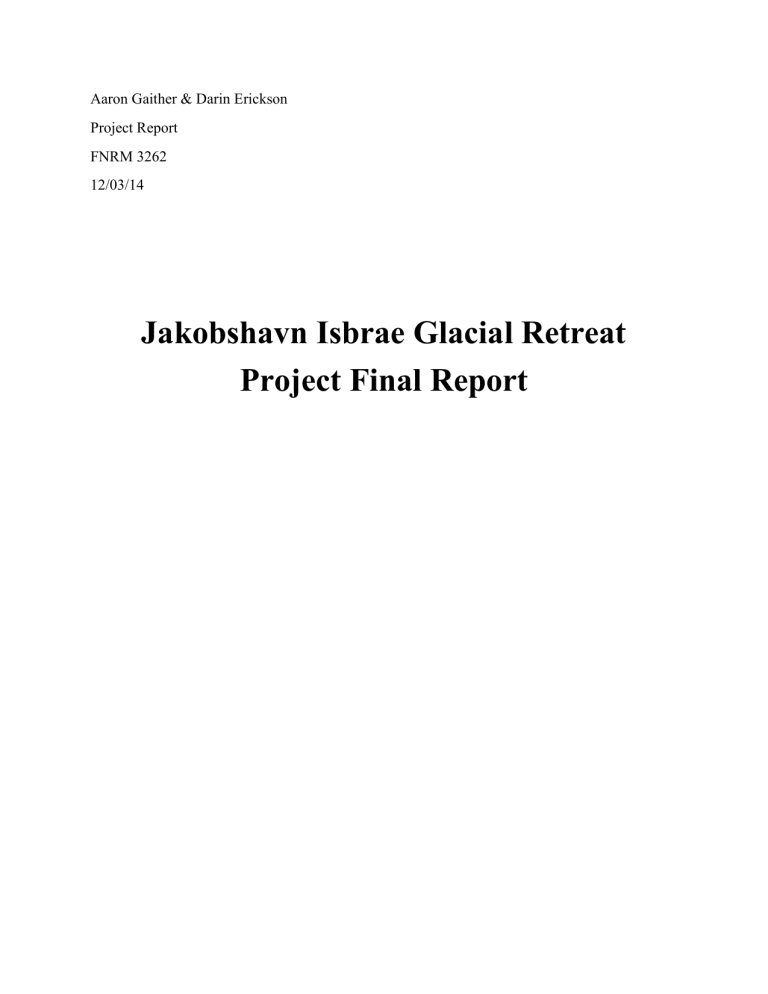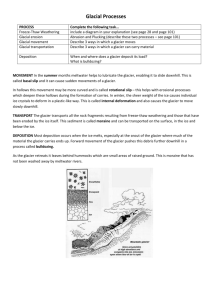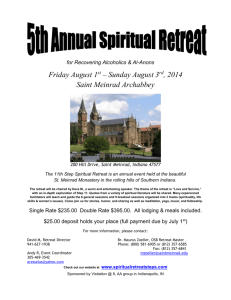Report

Aaron Gaither & Darin Erickson
Project Report
FNRM 3262
12/03/14
Jakobshavn Isbrae Glacial Retreat
Project Final Report
Project Description and Objective:
We want to be able to develop time lapse imagery showing the transformation of the
Jakobshavn Isbrae glacier in Greenland. The importance of this data can be used globally and locally. It can show how global warming is altering glaciers. This issue will also have an impact on global hydrology. As glaciers around the world are retreating they continuously release their stored water, this in turn will have an impact on sea levels. Due to the glacial retreat, fresh water loss may become an important issue in the near future to the local environment. We will analyze
5 different images to determine how far the glacier has retreated in the last 30 years. If data is available, we will try to compare average local temperature to glacial retreat.
The area of interest for our project is located on the west shore of Greenland. Our study area encompasses the entire Jakobshavn Isbrae glacier which covers roughly 3,819 km
2 and extends westward to the Arctic Ocean. Our data collection of glacial retreat covers roughly 2,050 km
2 within the study area (Alley). However, our data suggests that this area is dropping each year.
Materials, Tools and Concepts:
We used 5 different Landsat images for our data collection ranging from 1985 – 2014.
We used images from USGS Earth Explorer. All the images were collected from path 9 – row 11 with a Lat. (69.6) and Lon._ (- 49.4) with cloud cover less than 20 %. The table below describes the data correlated with our images including: Image ID, Landsat #, Image acquisition date and # of bands.
We also used Google Earth to initially identify the extent of the glacier and identify the coordinates we should use for the Landsat images.
Image ID Landsat #
LT50090111985184KIS00 Landsat 4-5 TM
LT50090111990166KIS00 Landsat 4-5 TM
LE70090112001188EDC00 Landsat 7 SLC-on
LE70090112009210EDC00 Landsat 7 SLC – off
LC80090112014184LGN00 Landsat 8 OLI
Image Acquisition
July 3 rd
, 1985
June 15 th
, 1990
July 7 th
, 2001
July 29 th
, 2009
July 3 rd
, 2014
# of Bands
9
9
7
7
12
Fig. 1
Procedures & Pre-processing
We found 5 Landsat images with less than 20% cloud cover that accurately portrayed our area of interest, over a 30 year time frame. We had difficulty finding images from Landsat 7 that truly displayed our area of interest. Coincidently, our 2009 image contains scan lines, but does not pose any problems with classification. All of the images are from the month of July except for year 1990 which is from June. In order to analyze our images, we needed to retrieve them from USGS Earth Explorer. For each image, we selected “download option” and chose level 1 product which provided use with data from each spectral band as well as other meta-data.
After downloading each image, we needed to extract the data from each zip file in order to work in Erdas Imagine. We assigned each image to a specific folder corresponding with the date of acquisition. Once in Erdas, we opened an empty 2D viewer. We then selected “Raster”,
“Spectral” and “Layer Stack” in that order. We then selected each individual Tiff file to be stacked in ascending order. After completing these steps for each of the five images, we were able to clearly view our area of interest. We set the spectral bands at 4 (red), 3 (green), 2 (blue) for all images up to 2009. For our Landsat 8 image from 2014, we set the spectral bands at 5
(red), 4 (green), 3 (blue). With all of our images successfully extracted and stacked, we were then able to create subset the images.
To create a subset image we used the “help” tool to identify the “subset” function. After identifying this function, we chose to do a four corner subset image. The coordinates for each image are as follows:
ULX 486690.98
7699142.5 ULY
LRX 581497.47
7658999.21 LRY
URX
URY
581497.47
7699142.5
LLX
LLY
486690.98
7658999.21
Fig. 2
Classification and Analysis
After completion of our pre-processing, it was time to classify the images. Initially we used an unsupervised classification with 7 classes, 50 maximum iterations and .98 convergence threshold to identify the different cover types. We chose to identify: Snow Cover, Open Water,
Cloud Cover, Fjord Ice, Glacier, Vegetative Cover and Non-Vegetative Cover. The unsupervised classification was unsuccessful with all images to correctly identify the cover types. We then decided to run a supervised classification with maximum likelihood as our parametric rule. We created 10 polygons within each cover type, all within our area of interest. We then generated
classified images for each Landsat image. This approach worked moderately well except for a few minor errors.
The 1985 image contained cloud cover on the South East portion of the image. However, this does not affect our goal of analyzing glacial retreat. The 1990 classified image had difficulty distinguishing between the glacial edge and snow cover of the northern inlet. We believe this is due to the fact that it is the only image taken in June rather than July, thus comprising of more snow cover. We will use the actual Landsat image to digitize a polyline to define the northern glacial outlet. The last error we had with classification was scan lines in our 2009 image. This was not too difficult to overcome. We assigned a pixel value to correspond to the scan lines. This differentiated those pixels from already assigned classes. We were then able to accurately identify the glacial edge and other cover types. While we were able to differentiate between cover types, our accuracy assessment was negatively affected by this error due to a histogram value of 0.
After classifying the images we needed to run an accuracy assessment of each image. To do this we selected Raster > Supervised > Accuracy Assessment. After assigning the appropriate images to the assessment, we were able to set our parameters. We used a search count of 1024,
50 points with a minimum of 10 points. We chose stratified random for our distribution parameters. By choosing stratified random, we were able to have an equal distribution of points across the image while still maintaining randomization within each classified pixel value. The accuracy results are as follows:
1985 Image
Class Name
Snow Cover
Glacier
Non Vegetated
Water
Vegetation
Reference
Totals
0
20
2
6
13
Classified
Totals
0
20
2
6
13
Fjord Ice
Cloud Cover
Totals
8
1
50
8
1
50
Overall Classification Accuracy = 100%
Fig. 3
Number
Correct
0
20
2
6
13
8
1
50
Producers
Accuracy
---
100%
100%
100%
100%
100%
100%
Users
Accuracy
---
100%
100%
100%
100%
100%
100%
1990 Image
Class Name
Glacier
Water
Reference
Totals
16
8
Classified
Totals
18
8
Fjord
Bare Soil
Vegetation
Snow Cover
7
3
10
6
9
6
5
4
Overall Classification Accuracy = 94%
Fig. 4
Number
Correct
16
8
9
6
5
3
Producers
Accuracy
100%
100%
71%
100%
90%
100%
Users
Accuracy
89%
100%
100%
75%
100%
100%
2001 Image
Class Name
Water
Vegetation
Fjord
Non
Vegetation
Glacier
Snow
Totals
Reference
Totals
13
10
7
1
19
0
50
Classified
Totals
9
12
10
2
17
0
50
Overall Classification Accuracy = 80%
Fig. 5
Number
Correct
9
10
5
1
15
0
40
Producers
Accuracy
69%
100%
71%
Users
Accuracy
100%
83%
50%
100%
79%
---
50%
88%
---
2009 Image
Class Name
Scan Line
Water
Non
Vegetation
Vegetative
Fjord
Glacier
Reference
Totals
0
8
1
13
5
23
Classified
Totals
0
5
3
14
11
17
Totals 50 50
Overall Classification Accuracy = 72%
Fig. 6
Number
Correct
0
5
1
12
3
15
36
Producers
Accuracy
---
63%
Users
Accuracy
---
100%
100%
92%
60%
65%
33%
86%
27%
88%
2014 Image
Class Name
Water
Vegetation
Non Vegetation
Fjord
Reference
Totals
10
12
1
7
Classified
Totals
9
12
2
10
Glacier
Totals
20
50
17
50
Overall Classification Accuracy = 90%
Fig. 7
Number
Correct
9
11
1
7
17
45
Producers
Accuracy
90%
92%
100%
100%
85%
Users
Accuracy
100%
92%
50%
70%
100%
We used ArcGIS to calculate the distance and area of total retreat of both the main glacier and northern outlet glacier. We created polyline shape-files for each Landsat image to identify glacial boundaries. To do this, we selected Catalog > Folder Connections > E: Drive >
Respective Folder. Within that folder we created a new polyline shape-file. After all polylines were created, we were able to calculate the total distance of retreat and total change in area. We retrieved these values by using the measure tool in ArcGIS, this allowed us to calculate area and average distance. We computed values of change relative to 1985 and change relative to the previous study year.
Current Results and Images:
Throughout our project we were able to generate many images and tables to help evaluate the retreat of Jakobshavn Glacier. The image shown below is a 2014 Landsat image with each glacial boundary from respective years. The two main study areas we focused on were the
Northern Outlet and the Main Glacier.
Northern Outlet
Main Glacier
Fig. 8
The extent of glacial retreat from 1985 can be evaluated from this image. It is relatively simple to notice a change in glacial boundary. From 1985 – 1990 there was an advance in glacial edge. In years following 1990, there was significant retreat of glacial boundaries within both
study areas. Below is a table that represents retreat distance and change in area relative to the previous study year.
Year
1985 -1990
1990 -2001
2001- 2009
2009-2014
Fig. 9
Main Glacier
Retreat Distance
(km)
-1.15
2.57
12.52
2.27
Change in Area
(km 2 )
-7.88
22.98
144.35
31.6
Retreat Distance
(km)
North Outlet
Change in Area
(km 2 )
-0.745
0.957
2.05
0.453
-1.64
2.11
6.19
2.29
Each value represents change relative to the previous study year. Negative values represent growth in glacier while positive values represent retreat. We noticed a significant retreat distance and change in area in years 2001 – 2009. We calculated 75% of the total glacial retreat occurred between the years of 2001 – 2009. Below is a table that represents retreat distance and change in area from 1985.
Year since 1985
5
16
24
29
Main Glacier
Retreat
Distance since
1985 (km)
-1.15
1.42
13.94
16.20
Area lost since 1985
(km2)
-7.88
15.1
159.45
191.05
Total
North Outlet
Distance since
1985 (km )
-0.75
0.20
2.25
2.70
Area since
1985 (km2)
-1.64
0.47
6.66
8.95
Fig. 10
Each value represents change relative to 1985. Negative values represent growth in glacier while positive values represent retreat. With this data we were able to calculate an average retreat distance of .56 km/yr and a total retreat distance of 16.2 km. We also calculated an area loss of 6.6 km 2 /yr and a total of 8.95 km 2 since 1985. According to the Polar Research
Center of Ohio State University, “Jakobshavn glacier is one of the world’s fastest moving
glaciers reaching speeds up to 7 km/year” (Hong-Gyoo). Figures 11 and 12 help visualize the change in retreat distance of the main glacier and northern outlet.
Main Glacial Retreat Distance
Fig. 11
2009-2014
2001- 2009
1990 -2001
1985 -1990
-2,00 0,00 2,00 4,00 6,00
Distance (km)
8,00 10,00 12,00 14,00
North Outlet Glacial Retreat Distance
2009-2014
2001- 2009
1990 -2001
1985 -1990
-1 -0,5 0 0,5 1
Distance (km)
1,5 2 2,5
Fig. 12
We were able to retrieve data of average monthly and yearly temperature near
Jakobshavn glacier from tutiempo.net. We chose to collect data from the month of July to not only represent our image retrieval date but also the months consistently above freezing. The information collected is represented in Figure 13 below. We noticed a slight increase in average
yearly temperature from 1985 – 2013. While an increase of only 1-2 deg. Celsius may not appear to be significant, it warrants a correlation between glacial retreat and rising temperature. We also noticed a substantial increase in temperature of 9.1 deg. Celsius between the years 2003 – 2008.
This is also the time frame of the major glacial retreat.
Jakobshavn Yearly and Monthly Average Temperature
15
10
5
0
-5
-10
1990 1995 2000
Average annualTemp. C deg.
Линейная (Average annualTemp. C deg.)
Year
2005 2010
Average Monthly Temp. July
Линейная (Average Monthly Temp. July)
2015
Fig. 13
Discussion:
The evaluation of glacial retreat of Jakobshavn Glacier has revealed many important findings. However, there were several challenges to overcome in order to accurately assess glacial retreat. Our first challenge was to find suitable Landsat images. This meant finding downloadable images, scan-line free, low atmospheric interference and date acquisition. We were able to find four images that clearly represented our area. Our fifth image of 2009 contained scan lines, but we were able to accurately identify the glacial edge and compute data.
As discussed earlier, we had difficulty classifying our images correctly due to snow cover over vegetated and non-vegetated areas. We used the previous images to help determine the
correct classification. We conducted an accuracy assessment of all of the classified images. In
1985 we obtained 100% accuracy. We are skeptical of the results because it is highly unlikely to achieve this level of accuracy. We may have simply had incredible luck with that particular assessment.
We initially hypothesized that temperature will have a strong correlation with the retreat of the glacier. We were surprised that the glacier advanced between the years of 1985 – 1990.
This is important to understand because there can be many influences on glacial retreat that we have not fully identified. We also obtained our average temperatures of the local area rather than the average temperature of the entire area of Greenland. This was important because the West coast, Jakobshavn glacier, is consistently warmer than the rest of Greenland. While we fail to reject our hypothesis, we will take into consideration that the increase in temperature was minimal resulting in a weak correlation between temperature and glacial retreat.
While the data collected is sufficient to monitor glacial retreat, there can be extended research on the area. This research would include data collection of surrounding Labrador Sea temperature, change detection of vegetation and exposed land area, comparison to similar glaciers and further understanding of historical measurements prior to 1985. With more research and data collection of the area, we might be able to present a stronger correlation between temperature and glacial retreat.
Sources:
Alley, Richard B.
,
Peter U. Clark, Philippe Huybrechts, Ian Joughin
.
Ice Sheet and Sea Level
Changes. < http://www.sciencemag.org/content/310/5747/456.full
> 10/21/05. Web. 12/3/14
Hong-Gyoo, Sohn. Jakobshavn Glacier, West Greenland: 30 Years of Space Born Obstervation.
< onlinelibrary.wiley.com/doi/10.1029/98GLO1973/pdf > 7/15/1998. Web. 12/3/14
Software used: Erdas Imagine and ArcMap10.2. 2014
Tu Tiempo: World Weather - Local Weather Forecast. Historical Weather: ILULISSAT.weather station 42210 “BGQQ” < http://www.tutiempo.net/en/Climate/ILULISSAT_JAKOBSHA/42210.htm
> 2014. Web.
11/26/14
U.S. U.S. Geological Survey. Glovis. Path 9, Row 11: 07/03/1985, 06/15/1990, 07/07/2001,
07/29/2009, and 07/03/2014. < http://glovis.usgs.gov/ > 2014. Web.Oct/15-21 of 2014
Appendix:
Year
1992
2001
2002
2003
2004
2005
2006
2007
2008
1993
1994
1995
1996
1997
1998
1999
2000
2009
2010
2011
2012
2013
Average Annual Temp. C
Deg.
-7.1
-3.2
-3.8
-2.7
-6.5
-4.2
-3.4
-2.7
-3.7
-6.9
-5.9
-4.9
-3.9
-3.7
-2.9
-4.7
-2.9
-3.2
-0.1
-4
-3
-3.2
Year
2000
2001
2002
2003
2004
2005
2006
2007
1992
1993
1994
1995
1996
1997
1998
1999
2008
2009
2010
2011
2012
2013
Average Monthly
Temp. July C. Deg.
6.4
9
7
8.5
4.3
6.7
13.4
9.6
9.3
8.3
7.5
9.1
6.8
5.9
8.9
9.1
8
9
8.7
10.2
9.3
7.5







